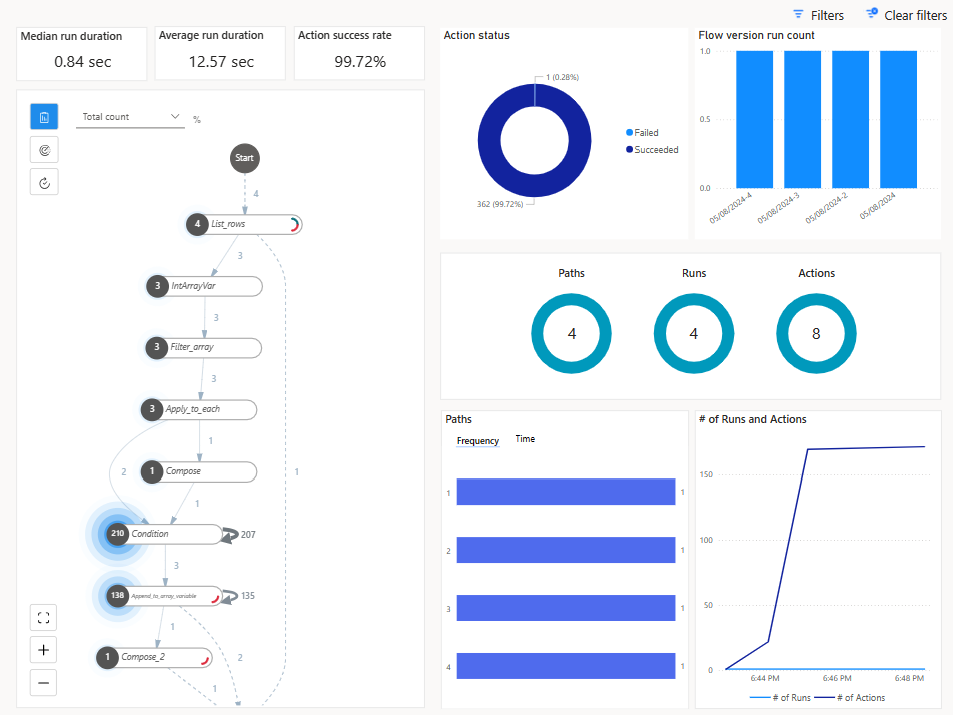Run and monitor a cloud flow
Once your flows are created and running, it's important to monitor their performance. Power Automate provides a robust suite of tools designed to monitor, analyze, and optimize cloud flows. These tools ensure workflows run smoothly while delivering actionable insights to improve performance and resolve issues. This section highlights how built-in analytics can be used to track flow activity, identify errors, and uncover trends that support continuous improvement.
Key benefits of proactively monitoring your flows are:
Identify and resolve issues: Regular monitoring allows you to quickly detect and address problems such as errors or delays in flow execution. For example, if a flow fails due to a missing connection, monitoring tools can pinpoint the issue, enabling swift resolution to minimize disruptions.
Enhance performance: By analyzing flow performance, you can identify areas for optimization, such as reducing unnecessary actions or improving trigger conditions. These adjustments lead to more efficient workflows and increased productivity across processes.
Ensure security and compliance: Monitoring helps uncover potential security vulnerabilities or compliance risks within your flows. For instance, tracking data usage can reveal unauthorized access or improper handling of sensitive information, ensuring workflows remain secure and adhere to regulatory standards.
Understand usage patterns: Analytics provide valuable insights into how flows are utilized, revealing trends in frequency, user activity, and resource consumption. For example, if a flow is triggered excessively during peak hours, you can adjust its design to balance workloads and improve cost-effectiveness.
Businesses can maintain reliable workflows, proactively address challenges, and make informed decisions to optimize operations using these monitoring capabilities.
Monitor cloud flows using built-in analytics
The easiest way to analyze your flows is to use the built-in analytics. These analytics provide a centralized view of your flow’s performance, usage, and error patterns. These insights are accessible from the flow details page and are designed to help makers and administrators understand how flows are running and where potential issues may arise.

There are three main sections available:
Flow usage: The usage metrics display the number of actions executed by your cloud flows over time. For example, if a flow is triggered frequently but performs unnecessary actions, this data can help you identify opportunities to streamline the process and reduce resource consumption.
Error analysis: Error analysis provides detailed information about the types of errors encountered, their frequency, and the last time they occurred. For instance, if a flow consistently fails due to a missing connection or invalid input, the error analysis tab highlights these issues, allowing you to address them promptly.
Execution history: The execution history tracks your flow runs over the past 30 days, offering a timeline of successes and failures. This feature is useful for identifying trends, such as recurring failures during specific times or under certain conditions, which can inform troubleshooting efforts.

Optimize cloud flows with process mining insights
Process mining in Power Automate is a powerful tool for analyzing flow performance and uncovering opportunities for improvement. Examining the run history and tracking performance trends over time allows process mining to provide actionable insights that help you refine workflows and ensure they operate efficiently. This feature is useful for identifying bottlenecks, monitoring changes, and accessing detailed execution data to make informed decisions about optimization.
Analyze performance: Process mining allows you to pinpoint specific steps in your flow that may be causing delays or inefficiencies. For example, if a flow step involving a database query consistently takes longer than expected, you can investigate the query’s design or the database’s performance to address the issue. Optimizing these slow steps can significantly improve the overall speed and reliability of your flow.
Track changes over time: With process mining, you can monitor how your flow’s performance evolves as you make adjustments or as external factors change. For instance, after optimizing a step, you can use process mining to confirm whether the changes have reduced execution time or improved success rates. This ongoing tracking ensures that your flows remain efficient and effective as business needs evolve.
Access run history: Detailed run history data is readily available from the flow details page, providing a comprehensive view of each flow’s execution. This data includes information such as trigger times, action durations, and error occurrences. It enables you to analyze past runs and identify patterns or recurring issues. For example, if a flow frequently fails during peak usage hours, the run history can help you diagnose the root cause and implement a solution.
By using process mining insights, you can take a data-driven approach to optimizing your cloud flows. Whether you’re addressing inefficiencies, monitoring improvements, or diagnosing recurring issues, process mining equips you with the tools needed to enhance performance. It also helps maintain reliable workflows.
Learn more: Improve cloud flows with process insights
